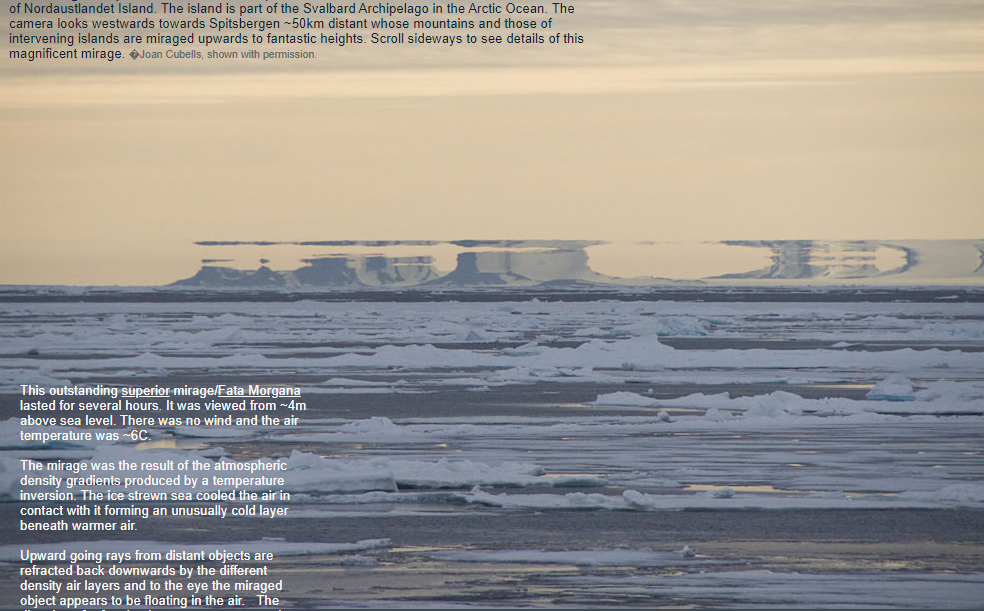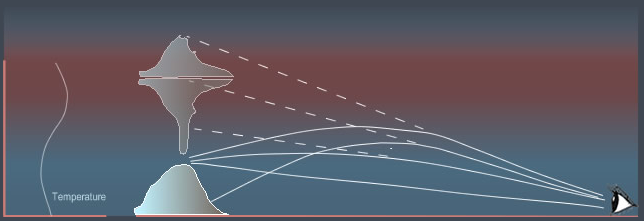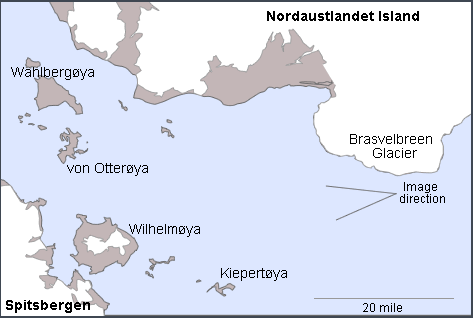Arctic Fata Morgana
Arctic Fata Morgana: A Spectacular Mirage Phenomenon
Mirages have long fascinated and perplexed observers with their ability to create optical illusions in the atmosphere. One particularly mesmerizing type of mirage is the Arctic Fata Morgana. This captivating phenomenon, characterized by distorted and elevated images of distant objects, occurs in the Arctic region due to specific atmospheric conditions.
The Arctic Fata Morgana is a superior mirage, also known as a Fata Morgana mirage, which lasts for several hours. It is caused by temperature inversions and atmospheric density gradients. In this case, the mirage was observed near the Brasvelbreen Glacier on Nordaustlandet Island in the Svalbard Archipelago, located in the Arctic Ocean. The camera captured the mirage looking westwards towards Spitsbergen, approximately 50 kilometers away. The mountains of both Spitsbergen and intervening islands appeared to be miraged upwards to incredible heights.
The Role of Atmospheric Density Gradients
The mesmerizing display of the Arctic Fata Morgana can be attributed to the unique atmospheric density gradients created by temperature inversions. In this instance, the ice-strewn sea cooled the air in contact with it, resulting in a colder layer beneath warmer air. This temperature inversion caused upward-going rays from distant objects to be refracted back downwards by the different density air layers.
The Illusion of Floating Objects
As a result of refraction, the miraged objects appear to be floating in the air. The direction of refraction curves the rays towards denser, colder air, creating a fascinating visual effect. In the case of the Arctic Fata Morgana, the refraction produced vertical magnification and exaggeration, which are characteristic features of Fata Morgana mirages.
Identifying the Mirage
Determining whether the mirage depicted ice floes or the distant mountains of Spitsbergen can be challenging. According to atmospheric refraction expert Andrew Young, the features observed in this particular mirage appear to be snow-covered rocks rather than just ice. While it is difficult to discern the exact targets of the mirage, it is likely that the island of Wilhelmøya and more distant high ground on Spitsbergen itself were involved.
A Spectacular Display
The Arctic Fata Morgana witnessed in this instance can be classified as a fine display of this mirage phenomenon. Although it may not exhibit the classical illusion of architectural features, it presents a complex structure with multiple images. Young suggests that there are at least seven images almost everywhere, possibly reaching nine or even eleven in certain areas. The intricate and captivating nature of this mirage truly makes it a spectacle to behold.
Exploring the Surrounding Area
To gain a better understanding of the observed mirage, Steinar Midtskogen, an individual who has explored the region extensively, provided a marine chart for reference. Based on this chart, it is possible that the island of Wilhelmøya and distant high ground on Spitsbergen were the main targets of the mirage. This additional information enhances our understanding of the specific geographic elements involved in creating the Arctic Fata Morgana.
In conclusion, the Arctic Fata Morgana is a remarkable mirage phenomenon that occurs in the Arctic region under specific atmospheric conditions. Temperature inversions and atmospheric density gradients play a crucial role in creating this optical illusion. The mesmerizing display of elevated and distorted images of distant objects adds to the allure of this phenomenon. While identifying the exact targets of the mirage can be challenging, it is evident that the mirage observed in this instance was a truly spectacular display. With further exploration and analysis, we can continue to unravel the mysteries behind this captivating atmospheric optics phenomenon.

Fata Morgana by Joan Cubells from a ship near the Brasvelbreen Glacier on the southern coast of Nordaustlandet Island. The island is part of the Svalbard Archipelago in the Arctic Ocean. The camera looks westwards towards Spitsbergen ~50km distant whose mountains and those of intervening islands are miraged upwards to fantastic heights. Scroll sideways to see details of this magnificent mirage. �Joan Cubells, shown with permission.

This outstanding superior mirage/Fata Morgana lasted for several hours. It was viewed from ~4m above sea level. There was no wind and the air temperature was ~6C.
The mirage was the result of the atmospheric density gradients produced by a temperature inversion. The ice strewn sea cooled the air in contact with it forming an unusually cold layer beneath warmer air.
Upward going rays from distant objects are refracted back downwards by the different density air layers and to the eye the miraged object appears to be floating in the air. The direction of refraction is to curve rays towards denser colder air. Where refraction is strong and there is ray crossing the upper image is inverted. In this example the refraction has produced vertical magnification and exaggeration, a characteristic of Fata Morgana mirages.
Is the mirage of ice floes or of the 50-60 km distant mountains of Spitsbergen?
Atmospheric refraction, green flash and mirage expert Andrew Young comments: �I'm inclined to think it was land and not ice that was miraged. However, there are some offshore islands that might have been the targets, rather than the body of Spitsbergen itself. The features certainly appear to be snow-covered rocks, not just ice.
I think this can be classified as a Fata Morgana, though it doesn't produce the classical illusion of architectural features. There are at least 7 images almost everywhere; in some places, I'm sure there are 9. And maybe some of the complex structure at the right shows 11 images in a few places. This is certainly a fine display!�
Steinar Midtskogen who has traveled the area kindly dug out a marine chart on which the map at right is based. The island of Wilhelmøya was possibly miraged combined with more distant high ground on Spitsbergen itself.


Fata Morgana & Superior mirages All mirages
Note: this article has been automatically converted from the old site and may not appear as intended. You can find the original article here.
Reference Atmospheric Optics
If you use any of the definitions, information, or data presented on Atmospheric Optics, please copy the link or reference below to properly credit us as the reference source. Thank you!
-
<a href="https://atoptics.co.uk/blog/arctic-fata-morgana/">Arctic Fata Morgana</a>
-
"Arctic Fata Morgana". Atmospheric Optics. Accessed on December 23, 2024. https://atoptics.co.uk/blog/arctic-fata-morgana/.
-
"Arctic Fata Morgana". Atmospheric Optics, https://atoptics.co.uk/blog/arctic-fata-morgana/. Accessed 23 December, 2024
-
Arctic Fata Morgana. Atmospheric Optics. Retrieved from https://atoptics.co.uk/blog/arctic-fata-morgana/.